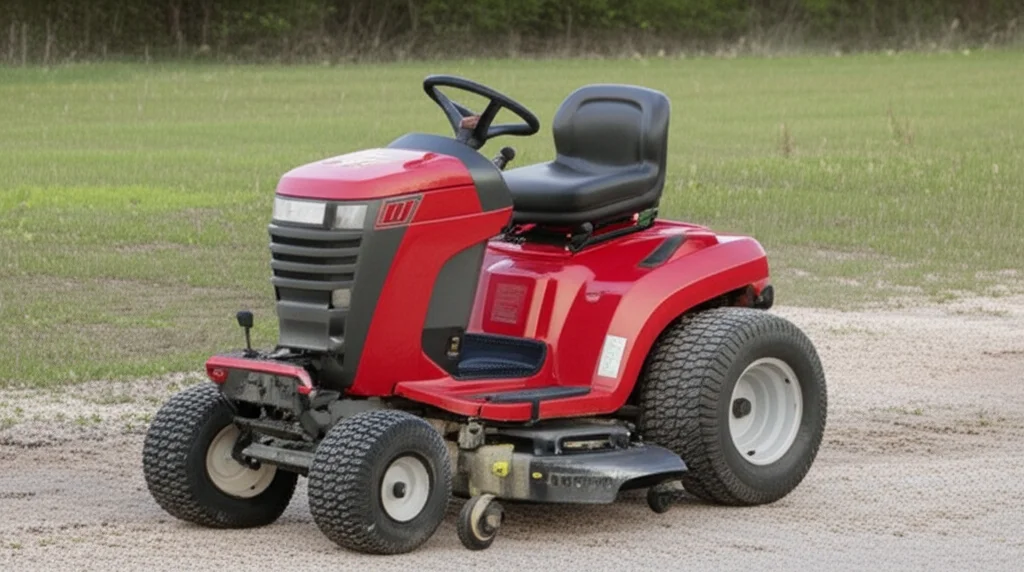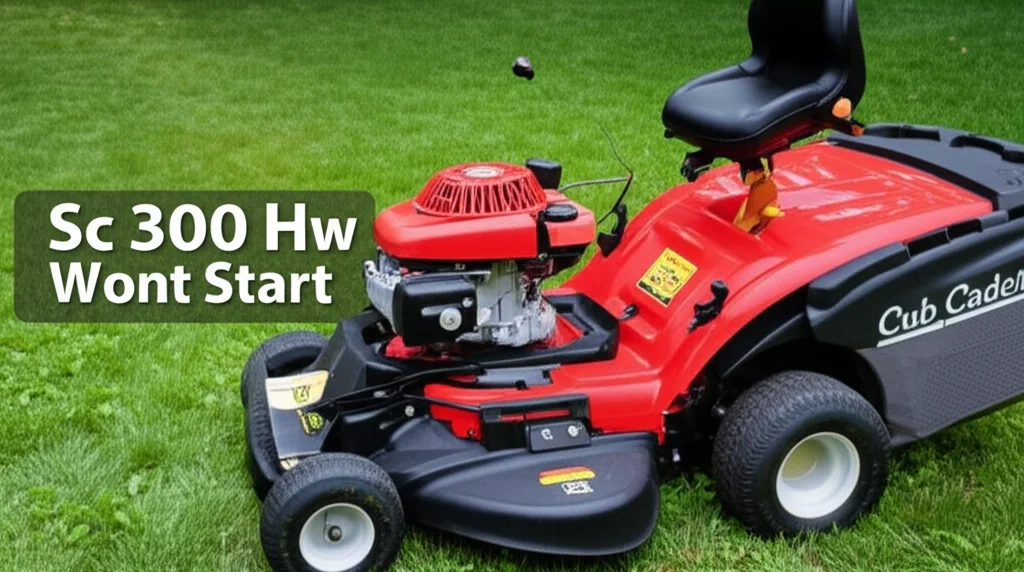· Lawn Mower Repair · 14 min read
Craftsman Riding Mower Will Go In Reverse But Not Forward

Why Your Craftsman Riding Mower Will Go In Reverse But Not Forward: Complete Troubleshooting Guide
Does your Craftsman riding mower stubbornly refuse to move forward while reverse works perfectly fine? This frustrating issue affects many lawn tractor owners and can quickly turn a routine mowing session into a maintenance headache.
When your Craftsman riding mower will go in reverse but not forward, several mechanical, hydraulic, or electrical problems could be causing this directional dilemma.
In this comprehensive guide, we’ll walk through the most common causes behind this specific problem, provide step-by-step troubleshooting procedures, and offer practical solutions to get your mower moving in the right direction again.
Whether you’re dealing with transmission problems, drive belt issues, or control linkage malfunctions, our expert advice will help you diagnose and fix the problem efficiently.
Key Takeaways:
- Transmission issues are the most common culprit when a Craftsman riding mower goes in reverse but not forward
- Checking drive belts, linkage components, and hydraulic systems can resolve most forward motion problems
- Many fixes can be completed at home with basic tools and mechanical knowledge
- Proper maintenance prevents recurring directional control problems
- Safety should always come first when troubleshooting riding mower issues
Quick Answer: When a Craftsman riding mower will go in reverse but not forward, the most likely causes are a broken or slipping drive belt, damaged forward gear in the transmission, improperly adjusted motion control linkage, low hydraulic fluid, or a faulty forward drive clutch.
Understanding Why Your Craftsman Riding Mower Only Moves in Reverse
When your Craftsman riding mower only moves backward but refuses to go forward, it’s essential to understand that different mechanical systems control forward and reverse motion. Most Craftsman riding mowers use either a gear-driven transmission or a hydrostatic transmission system to control direction and speed.
The forward and reverse functions operate on separate mechanisms within these transmission systems. This design explains why one directional function can fail while the other continues working perfectly. In gear-driven models, specific gears handle forward motion, while others manage reverse. Similarly, in hydrostatic transmissions, separate hydraulic channels control forward and reverse operations.
Common transmission types in Craftsman riding mowers include:
- Manual gear transmissions: Use mechanical gears for different speeds and directions
- Hydrostatic transmissions: Utilize hydraulic fluid pressure to control speed and direction
- Automatic transmissions: Combine elements of both systems with electronic controls
Understanding which transmission type your mower uses helps narrow down potential causes. For instance, hydrostatic transmission problems often involve fluid levels or internal valve issues, while gear transmission troubles typically relate to mechanical components like gears, linkages, or belts.
Before diving into specific repairs, it’s worth noting that some issues might be surprisingly simple to fix, while others could require professional attention or part replacement. Let’s examine the most common causes in detail.
Common Causes of Forward Motion Failure in Craftsman Riding Mowers
1. Drive Belt Problems
The drive belt is one of the most frequent culprits when a Craftsman riding mower goes in reverse but not forward. This belt transfers power from the engine to the transmission and can affect directional movement when damaged.
Signs of drive belt issues:
- Visible wear, fraying, or cracking on the belt surface
- Belt appears loosely hanging or sagging
- Burning smell during operation
- Strange noises when attempting to move forward
Drive belts can wear differently depending on usage patterns. The section of the belt that engages during forward motion might be more worn than the section used for reverse. This uneven wear can result in a mower that moves backward but struggles to go forward.
To inspect the drive belt:
- Turn off the mower and remove the ignition key
- Wait for all moving parts to stop completely
- Access the drive belt (usually requires removing the mower deck or a cover plate)
- Check for visible damage, proper tension, and alignment
If you find a damaged drive belt, replacement is typically straightforward and cost-effective compared to more complex transmission repairs. Most Craftsman models use standardized belt sizes that can be purchased at hardware stores or online.
2. Transmission Issues
The transmission system in your Craftsman riding mower is responsible for transferring power to the wheels and controlling direction. When forward motion fails, internal transmission problems are often responsible.
Hydrostatic Transmission Problems
Many newer Craftsman models use hydrostatic transmissions that rely on hydraulic fluid pressure. Common hydrostatic issues include:
- Low hydraulic fluid: Insufficient fluid can cause directional problems
- Air in the hydraulic lines: Creates pockets that prevent proper pressure buildup
- Damaged pump or motor: Internal components may be worn or broken
- Clogged filter: Restricts proper fluid flow through the system
Hydrostatic transmissions require periodic purging to remove air from the system. If your mower hasn’t been used for some time or the transmission fluid was recently changed, air might be trapped in the system.
Gear-Driven Transmission Problems
For older Craftsman models with gear-driven transmissions, common issues include:
- Broken or worn forward gears: Internal gears can strip or break
- Shift fork problems: The mechanism that shifts between gears may be damaged
- Clutch disc wear: Prevents proper engagement when moving forward
- Adjustment issues: Improper calibration of the shift linkage
Transmission problems often require more technical expertise to diagnose and repair than other issues. If you suspect transmission trouble, you might need specialized tools or professional assistance.
3. Control Linkage Problems
The control linkage system connects your speed and direction controls (pedals or levers) to the transmission. Problems with this system can cause directional failures.
Common linkage issues include:
- Disconnected linkage components
- Broken or bent control rods
- Missing or damaged cotter pins and fasteners
- Excessive rust or corrosion causing binding
- Improper adjustment preventing full range of motion
To check control linkages:
- Locate the motion control linkage (usually follows from the direction control pedals/levers to the transmission)
- Ensure all connections are secure and properly attached
- Check for free movement through the entire range
- Look for visible damage, bending, or excessive rust
- Verify proper adjustment according to your model’s specifications
Linkage problems are often easy to spot visually and relatively simple to fix with basic tools. Adjusting, lubricating, or replacing damaged linkage components can often restore proper forward motion.
How to Diagnose When Your Craftsman Riding Mower Won’t Go Forward
Proper diagnosis is essential before attempting repairs. Following a systematic approach helps identify the exact cause of your forward motion problems.
Step 1: Initial Inspection and Basic Checks
Before diving into complex diagnostics, start with these basic checks:
- Verify the parking brake is disengaged - A common oversight that prevents forward motion
- Check the neutral safety switch - This switch can prevent movement if not properly engaged
- Ensure proper seat switch operation - Many mowers won’t operate if the seat switch doesn’t detect the operator
- Verify the motion control lever is properly positioned - Some models have specific engagement procedures
- Confirm adequate fuel level - Low fuel can cause inconsistent performance
These simple checks eliminate common user errors before investigating mechanical issues.
Step 2: Inspect the Drive System
After confirming basic operational requirements:
- Examine the drive belt condition - Look for wear, proper tension, and alignment
- Check pulley condition - Ensure pulleys rotate freely and aren’t damaged
- Inspect idler pulleys and tensioners - These components maintain proper belt tension
- Look for debris or obstructions - Foreign objects can interfere with mechanical components
- Verify wheel condition - Ensure wheels and axles move freely when pushed manually
Pay particular attention to any unusual noises, resistance, or vibrations during this inspection.
Step 3: Test the Transmission System
For the transmission system:
- Check transmission fluid levels (for hydrostatic models) - Low fluid can cause direction-specific problems
- Inspect for leaks - Look for fluid puddles or stains beneath the mower
- Test bypass valve operation (if equipped) - This valve allows manual movement when engaged
- Check transmission cooling fins - Overheating can cause intermittent direction problems
- Verify proper clutch operation - The clutch transfers power to the transmission
For hydrostatic transmissions, air in the system might require purging following the procedure in your owner’s manual.
Step 4: Evaluate Control Linkages
For control linkage evaluation:
- Trace the entire linkage path from controls to the transmission
- Check for disconnections or loose fasteners
- Verify range of motion through the entire control path
- Look for binding points where movement is restricted
- Ensure proper adjustment according to specifications
Taking photos before disassembly helps with proper reassembly if you need to remove components for better access.
DIY Fixes for Forward Motion Problems in Craftsman Riding Mowers
Many forward motion issues can be resolved with DIY repairs. Here are step-by-step solutions for the most common problems:
Replacing a Worn Drive Belt
A worn or damaged drive belt is a frequent cause of directional problems. Here’s how to replace it:
- Park on level ground and turn off the engine
- Remove the ignition key and disconnect the spark plug wire
- Remove the mower deck (if necessary) following your model’s manual
- Locate the drive belt that connects the engine pulley to the transmission pulley
- Release tension using the idler pulley or tensioner
- Remove the old belt and note its routing pattern
- Install the new belt following the same routing pattern
- Reset the tensioner and verify proper tension
- Reinstall any removed components
- Test forward and reverse operation
Use only manufacturer-recommended replacement belts to ensure proper fit and performance.
Purging Air from a Hydrostatic Transmission
Air in the hydrostatic system can cause direction-specific problems. Purge air using this procedure:
- Start with the engine off and the mower on level ground
- Locate the transmission bypass valve(s) (refer to your manual for location)
- Open the bypass valve(s) to release pressure
- Push the mower forward and backward several times (about 5 feet each direction)
- Close the bypass valve(s) to normal operating position
- Start the engine and let it run for a few minutes
- Test forward and reverse movement at slow speed
- Repeat the process if necessary until smooth operation is restored
This procedure helps eliminate air pockets that can interfere with hydraulic pressure needed for forward motion.
Adjusting Control Linkages
Improper linkage adjustment can cause directional problems. Here’s how to adjust them:
- Access the control linkage (typically under the mower or near the transmission)
- Identify adjustment points - usually threaded rods with locknuts
- Loosen the locknuts to allow adjustment
- Adjust rod length according to specifications (usually by turning the rod)
- Test the control range through full forward and reverse positions
- Tighten locknuts once proper adjustment is achieved
- Verify smooth operation through the entire range of motion
Different Craftsman models have specific adjustment procedures, so consult your owner’s manual for exact specifications.
Checking and Replacing a Forward Drive Clutch
A faulty drive clutch can cause forward motion failure. Here’s how to check and replace it:
- Access the clutch assembly (usually requires removing covers or guards)
- Inspect clutch components for visible damage or wear
- Check for proper engagement when controls are activated
- Test electrical connections if using an electric clutch
- Remove the clutch assembly if replacement is needed
- Install the new clutch following proper torque specifications
- Verify proper alignment with engine and transmission pulleys
- Test operation before fully reassembling covers
Clutch replacement often requires specific tools and mechanical knowledge. Consider professional service if you’re uncomfortable with this procedure.
When to Seek Professional Help for Your Craftsman Riding Mower
While many issues can be resolved with DIY repairs, some problems require professional attention. Consider seeking expert help in these situations:
Complex Transmission Problems
Internal transmission damage often requires specialized knowledge and tools. Consider professional service when:
- You’ve verified the problem isn’t related to belts, linkages, or fluid levels
- There are unusual noises coming from the transmission
- You notice metal particles in the transmission fluid
- The transmission leaks excessively
- DIY purging procedures don’t resolve hydrostatic issues
Professional technicians have the equipment to properly diagnose and repair internal transmission components without causing additional damage.
Electrical System Failures
Modern Craftsman mowers incorporate electronic control systems that can affect directional control. Seek help when:
- Safety interlock systems malfunction
- Electronic control modules fail
- Wiring harnesses show damage
- Sensors provide incorrect readings
- Diagnostic codes indicate system failures
Electrical troubleshooting requires proper testing equipment and system knowledge that most home mechanics don’t possess.
When Repairs Exceed Equipment Value
Sometimes repair costs approach or exceed the value of an older mower. Consider professional assessment when:
- Your mower is more than 10-15 years old
- Multiple systems are failing simultaneously
- Previous repairs haven’t resolved persistent problems
- Transmission replacement is needed on an aging machine
A professional can provide a comprehensive evaluation and help determine whether repair or replacement makes more economic sense.
Preventing Future Forward Motion Problems in Your Craftsman Mower
Regular maintenance significantly reduces the risk of directional control problems. Implement these preventive measures:
Regular Maintenance Schedule
Follow these maintenance intervals:
- Every use: Check fluid levels and inspect belts
- Every 25 hours: Lubricate moving parts and check linkage adjustments
- Every 50 hours: Clean cooling fins and check filtration systems
- Every 100 hours: Change transmission fluid (if applicable)
- Annually: Comprehensive inspection of all drive components
Following manufacturer-recommended maintenance schedules prevents many common problems before they develop.
Proper Operating Techniques
How you operate your mower affects transmission longevity:
- Allow the engine to warm up before operation
- Shift direction controls only when completely stopped
- Avoid rapid directional changes
- Use appropriate speed for terrain conditions
- Don’t overload the mower with excessive towing weight
- Allow the transmission to cool before storage
These practices reduce strain on transmission components and extend service life.
Off-Season Storage Preparation
Proper storage prevents problems when returning to service:
- Clean the mower thoroughly before storage
- Change fluids before extended storage periods
- Remove or disconnect the battery
- Store in a dry, covered location
- Consider using fuel stabilizer if not draining the fuel system
- Perform pre-season maintenance before returning to service
These steps prevent deterioration during inactive periods and ensure smooth operation when mowing season returns.
FAQ: Common Questions About Craftsman Riding Mowers With Forward Motion Problems
What causes a riding lawn mower to not move forward?
The most common causes include worn drive belts, transmission problems, control linkage issues, low hydraulic fluid, or engaged bypass valves. Mechanical failures in the forward drive components can also prevent forward motion while still allowing reverse operation.
Why does my lawn mower cut off when I put it in reverse?
Most modern riding mowers have a safety feature called “Reverse Implementation System” (RIS) that cuts engine power when backing up unless specifically overridden. This is a safety feature, not a mechanical problem. Check your owner’s manual for instructions on properly operating the mower in reverse.
What are the symptoms of a bad starter solenoid on a riding mower?
A bad solenoid typically causes starting problems rather than motion issues. Symptoms include clicking sounds without engine cranking, intermittent starting, or complete failure to start. However, electrical systems are interconnected, so solenoid problems could potentially affect other electronic control systems.
How do I unlock my riding lawn mower transmission?
Most Craftsman riding mowers have a bypass lever or rod that disengages the transmission for manual pushing. This lever is typically located near the transmission or rear of the mower. When this lever is in the “bypass” position, the mower can be pushed manually but won’t drive under engine power. Return it to the engaged position for normal operation.
Can low transmission fluid cause my Craftsman mower to only move in reverse?
Yes, low transmission fluid in hydrostatic transmissions can cause direction-specific problems. The hydraulic system may have enough pressure for reverse operation but insufficient pressure for forward motion due to fluid level or air in the system. Always check fluid levels and condition when experiencing motion problems.
How do I know if my Craftsman mower’s transmission has failed?
Signs of transmission failure include unusual noises (grinding, whining), fluid leaks, inability to maintain consistent speed, complete loss of drive in one or both directions, or visible metal particles in the transmission fluid. Complete failure usually affects both forward and reverse motion.
Is it worth repairing an old Craftsman riding mower with transmission problems?
This depends on several factors including the mower’s age, overall condition, and repair cost versus replacement value. For mowers less than 8-10 years old with otherwise good engines and decks, transmission repair often makes economic sense. For older models with multiple issues, replacement might be more cost-effective.
Final Thoughts: Getting Your Craftsman Riding Mower Moving Forward Again
When your Craftsman riding mower will go in reverse but not forward, systematic troubleshooting is key to efficient repair. By following the diagnostic steps outlined in this guide, you can identify and fix most directional problems without expensive professional service.
Remember that regular maintenance is your best defense against transmission and drive system failures. Implementing a consistent maintenance schedule keeps your Craftsman riding mower performing reliably season after season.
Whether you’re dealing with a simple belt replacement or complex transmission issue, addressing problems promptly prevents additional damage and extends your mower’s service life. With proper care and timely repairs, your Craftsman riding mower can provide many years of dependable lawn maintenance service, moving smoothly in all directions.
If you’re experiencing similar problems with other mower brands, check out our guide on Husqvarna riding mower reverse problems for additional troubleshooting tips.
- riding mower repair
- Craftsman mower
- mower transmission
- lawn mower troubleshooting


